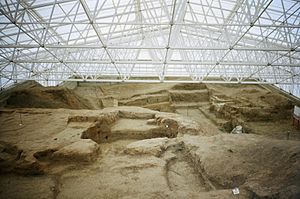 | ||
| Çatalhöyük | ||
| province | Konya | |
|---|---|---|
| Residents | unknown | |
| no value for residents on Wikidata: | ||
| height | unknown | |
| no value for height on Wikidata: | ||
| no tourist info on Wikidata: | ||
| location | ||
| ||
Çatalhöyük is an archaeological site in Central Anatolia.
background
Çatalhöyük ("Hill at the fork in the road") is one of the oldest cities of mankind. The first settlers are likely to be here around 6,700 BC. settled during the "Neolithic Revolution" (transition from the hunter-gatherer culture to the arable and livestock culture). The excavation consists of 12 settlement layers: layer X (around 6500 BC), view VIII and IX (around 6,380 to 6,280 BC), layer VIII (around 6,050 BC), layer VI A and B ( around 6,000 to 5,880 BC), layer V (around 5,800 BC), layers II to IV (around 5,790 to 5,720 BC). The city was founded around 5,600 BC. given up. But it was not destroyed by earthquake, fire or conquest. The residents of Çatalhöyük founded a new place on the other side of the river, which lasted until at least 4,900 BC. duration.
The inhabitants of Çatalhöyük were arable farmers and ranchers, artisans and merchants. They grew wheat, barley, and peas, and raised cattle, sheep, and goats. The craftsmen produced fine cloth, basket work and wickerwork, finely polished mirrors made of obsidian, pearls made of stone, copper and lead as well as high-quality ceramics. They imported flint from Syria, cowrie shells from the Red Sea and marble from the Aegean Sea. They extracted alabaster and obsidian from the area of the Erciyas Dag volcano (near Kayseri) and exported obsidian areas and weapons to Cyprus and probably also to Mesopotamia.
Catal Hüyük was founded in 1958 by the British archaeologist James Mellaart discovered and partially excavated between 1961 and 1963.
Çatalhöyük has been part of the UNESCO World Heritage since 2012.
getting there
By plane
The closest airport is in Konya to find.
By train
The nearest train station is in Konya.
In the street
Catal Hüyük is located 50 kilometers southeast of Konya. Around noon a bus leaves Konya for Çatalhöyük. The fare is approximately € 2.50. The way back is a little more difficult. Here you have to come to the nearby Çumra first. The best way is to ask for a transport service here at the museum. In Çumra you can change to a bus to Konya for € 2.50.
By boat
mobility
Tourist Attractions
Çatalhöyük was a highly developed city that should have had 10,000 inhabitants. The main hill is 450 meters long, 275 wide and covers an area of approximately 14 hectares. The hill is 17.5 meters high.

- The Houses are rectangular and are close together. They had walls made of air-dried bricks and flat roofs made of wooden beams and cane, which were sealed with a thick layer of clay. Inside and outside walls, ceilings and floors were plastered with fine, white clay. There were no streets or paths: the houses could only be reached via the roofs. So there were no front doors. Adjoining rooms, such as storage rooms, could only be entered through low hatches. The stove and oven were near the skylight. Raised platforms on the walls were used for sitting and sleeping. The skeletons of the dead of the family were buried under the platforms. The dead were first left to the vultures and predators and their skeletons, especially the skulls, were painted red, blue or green and wrapped with cloths or mats. They received nourishment for life in the afterlife in wooden vessels or baskets, but not in clay vessels. Men were buried with their weapons, women with their jewelry.
- The Places of worship are slightly larger than the residential buildings. They are decorated with wall paintings, plaster reliefs and buccranias. Animal skulls, animal horns, animal heads made of plaster, images of the mother goddesses made of clay and stone and stylized breasts were found here. Particular attention was paid to some wall reliefs, among other things. These all represent a four-legged creature. However, here everyone is missing the head because it was destroyed. Based on the clay figures, initial interpretations led to the conclusion that there was a representation of a mother goddess. Recent finds from the region Şanlıurfa but rather point to the representation of a reptile.
activities
shop
kitchen
nightlife
accommodation
health
Practical advice
trips
literature
Mellaart, James: Catal Hüyük - City from the Stone Age, Bergisch-Gladbach, 1967
Web links
- Homepage of the excavations [1] (English)

